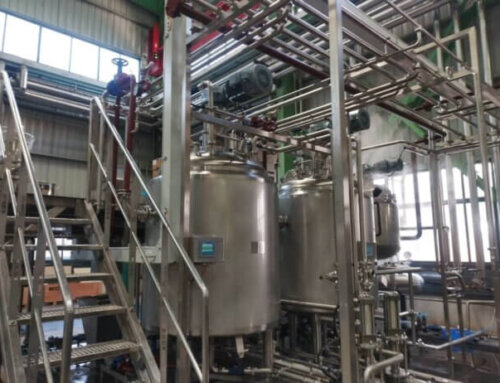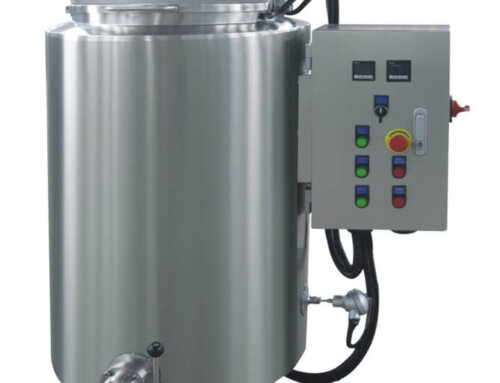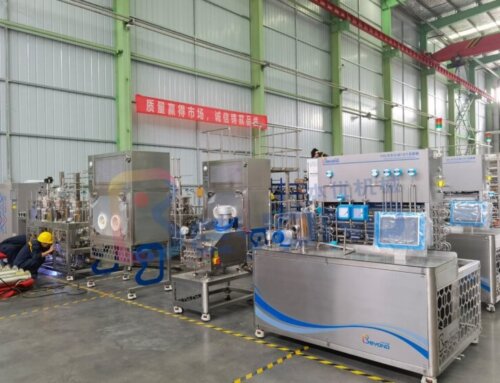RTD Beverage Processing Line Description
- RTD beverage is short for ready-to-drink beverage, It is a beverage that is made from fresh fruit or vegetable, fruit juice concentrated, herbal tea and filled into small containers like glass bottles, plastic bottles, metal cans, cartons. Most of the beverages we see on supermarket shelves are RTD beverages, it has the characteristic of being easy to consumption, easy to carry and has a long shelf life.
- From the perspective of soft drink classification, the RTD drinks are mainly divided into juice drinks, coffee and tea drinks, and energy drinks, carbonated juice drinks, alcoholic juice drinks can also be contained in the RTD drinks.
- The RDT drinks characteristically contain water, a sweetener (usually a carbohydrate, although artificial sweeteners are increasingly important), an acid (citric or malic and phosphoric in colas are the most common), flavoring, coloring and preservatives. There is a large range of additional ingredients that can be used for various effects like vitamins, minerals, nutrition fortifiers, etc.
- Ready–to–drink beverages can be made from a wide variety of fruits such as mango, guava, apple, citrus, pineapple, coconut, passion fruit, peach, grape, berry fruits, litchi, papaya and plum, it usually contains at least 10% fruit juice and 10% total soluble solids.
- The RTD drinks processing machine are all made of SUS304 material, it mainly includes juice preparation machines, ingredients mixing system, carbonation system, beverage sterilizing and filling system, container labeling and packing system, RO water generating system, CIP cleaning system.
- The capacity of the RTD Beverage processing line is from 500LPH-10000LPH, all the machine is with high configuration, flexible and customizable.

RTD Beverage Processing Line Type
RTD juice drinks: it is made from concentrated juice or fresh fruits, the end products will be filled into bottles, cans, aseptic brick cartons or pouches.
RTD tea or coffee drinks: It is made from fresh tea leaves or tea extract concentrate, the end products will be filled into bottles or cans.
RTD carbonated drinks: Add fruit juice or nutrient fortification substance, color agent, sugar and CO2 to make it into the drinks, and the end products will be filled into bottles or cans.
RTD alcoholic drinks: this drink is a popular trend, it can add juice, alcohol, flavorings, and the end products filled into glass bottles or metal cans. Like the cocktail.

RTD Beverage Processing Line Technological Flowchart
RTD beverage processing flowchart from fresh fruits or tea leave:

RTD beverage processing flowchart from juice concentrated:

RTD Beverage Process introduction
Fruit preparation system
In general terms, fruits are collected, sorted and washed, and then subjected to a type of mechanical compression appropriate for the fruit concerned. Although there are general fruit presses that can be used for more than one fruit type, fruits such as citrus, pineapple and stone fruits are usually processed in specially designed equipment.
Some fruit types (e.g. pome fruits, such as apples and pears) require mechanical treatment (milling), coupled with a biochemical process (involving enzymes) to break down the cellular structure and obtain the best yields. It is possible to achieve almost total liquefaction by means of an appropriate enzyme cocktail. Additionally, a diffusion or water extraction process can be used to obtain best yields from certain fruits.

RTD beverage preparation system
This station mainly includes two systems, the powder dissolving system and the RTD drinks preparation system.
The powder and water dissolving system mainly mix the sugar, flavorings, citric acid and other powder ingredients, after dissolving with hot water, it will be filtered and pasteurized then stored into the SUS304 tanks for use.
RTD drinks blending and preparation system can add juice, tea extracts or alcohol to make the different RTD drinks according to clients’ different requirements. After blending, some manufacturers want to make the drinks carbonated, then the mixed drinks will be pasteurized and cooled to 4 degrees and pumped to the carbonation mixer.

RTD beverage sterilization system
If the RTD beverage does not contain the CO2 or the alcohol content is less than 10%, then the RTD drinks need to be pasteurized or sterilized after formulation and ingredients mixing. The sterilization process depends on the specific situation. The sterilization temperature and time are related to whether the RTD beverage contains fruit juice or other nutrients and whether the later packaging style is aseptic packaging or hot filling.

RTD beverage filling and packing system
Traditionally, most beverages were packed in glass. Glass has many attractive features – not least that it is an excellent protective medium – but its overriding disadvantages are its weight and its brittleness. Despite this, high volumes of soft drinks and juices are still packaged in glass,
Some of it is multi‐trip packaging, the development of the board-polymer-aluminum package used to form in‐line boxes, which are packed aseptically, has been perhaps the outstanding packaging development for beverages. The pack provides an almost ideal combination of protection, minimal weight and economic size.
Another important packaging development area is plastic. Various plastics have been, and continue to be, used: for example, high‐ and low‐density polyethylene (HDPE, LDPE), polyvinyl chloride (PVC), polystyrene (PS) and various barrier plastics. These can be formed into bottles of conventional shape, or fed into machines producing form‐fill‐seal packages, typically cups. By far the most important plastic is polyethylene terephthalate (PET). Bottles of this material are formed in a two‐stage process. So‐called pre‐forms are made by injection moulding and, in a second process, are then stretch‐blow‐moulded to produce a bottle. PET has properties surprisingly like those of glass, but it does not have the same disadvantages of weight and brittleness. Processing systems that pack small PET containers aseptically are now in regular use.





